Class - 10 Science (Physics) Chapter - 10 Light - Reflection & Refraction Notes, NCERT Solutions & Frequently Asked Questions
Class - 10
Science (Physics)
Chapter - 10
Light - Reflection & Refraction
Notes, NCERT Solutions & Frequently Asked Questions
-- Notes --
Laws of Reflection
The angle of incidence is equal to angle of reflection
Incident ray, reflected ray and normal all lie in the same plane.
Spherical Mirrors
Most common type of curved mirrors are spherical mirrors. Mirrors in which reflecting surface are spherical in shape, is known as spherical mirrors. Reflecting surface of a mirror can be curved inwards or curved outwards. The one which is curved inward is known as concave mirror and the one which curved outwards is known as convex mirror.

Fig.1. Spherical mirrors
Some Important Terms
Pole- The centre of the reflecting surface in a spherical mirror is a pole. It is represented by P.
Centre of curvature- Reflecting surface in a spherical mirror has a centre, this is known as centre of curvature. Centre of curvature in convex mirror lies behind the mirror whereas in concave mirror, it lies in front of the mirror.
Radius of curvature- The radius of the reflecting surface of the spherical mirror is known as radius of curvature. It is represented by R.
Principal axis- Straight line passing through the pole and centre of curvature in a spherical mirror is known as principal axis.
Principal focus- The reflected rays appear to come from a point on the principal axis, this is known as principal focus.
Focal length- The distance between the pole and the principal focus in a spherical mirror is known as focal length and it is represented by f.
Aperture- The diameter of the reflecting surface is defined as aperture.
Note: Radius of curvature is twice the focal length (R=2f).

Fig.2. Image showing pole, principal axis, centre of curvature, aperture and principal focus in concave mirror
Representations of the images formed by Spherical Mirrors using Ray Diagrams
We draw the ray diagram to locate the image of an object formed. The intersection point of at least two reflected will give the position of image of the point object. The two rays that can be used to draw the ray diagram are-
A ray parallel to the principal axis should pass through the focus after reflection in case of concave mirror, or appear to diverge in case of convex mirror.

A ray passing through the focus of the concave mirror or directed towards the focus in case of convex mirror, should appear parallel to the principal axis after reflection.
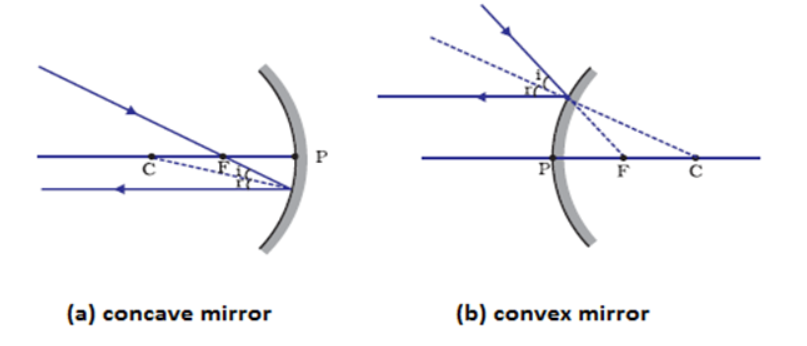
A ray which is passing through the centre of curvature in a concave mirror or directed in case of convex mirror, should reflect along the same path.

A ray when incident obliquely to principal axis on a concave or convex mirror is also reflected obliquely.

Image formation by Concave Mirror

Fig. 3. Ray diagram for the image formation by concave mirror
| Position of the object | Position of the image | Size of the image | Nature of the image |
| At infinity | At the focus F | Highly diminished | Real and inverted |
| Beyond C | Between F and C | Diminished | Real and inverted |
| At C | At C | Same size | Real and inverted |
| Between C and F | Beyond C | Enlarged | Real and inverted |
| At F | At infinity | Highly enlarged | Real and inverted |
| Between P and F | Behind the mirror | Enlarged | Virtual and erect |
Table.1. Nature, relative size and position of the image formed by concave mirror
Position, nature, and the size of the image formed by a concave mirror is dependent on the position of the object in relation to P, C and F. Image formed can be real or virtual. The image can also be magnified, diminished or even of the same size.
Uses of Concave Mirror
Used in search lights, torches, head lights of the vehicles. Also used in shaving mirrors. Used by dentists also to see larger image of the teeth. Other use in solar furnaces.
Image formation by Convex Mirror
Two positions of the object are considered while understanding the image formed by convex mirror. Either the object should be at infinity or at finite distance from the mirror. Formation of the image by the convex mirror are as follows-

Fig. 5. Ray diagram for the image formation by convex mirror
| Position of the object | Position of the image | Size of the image | Nature of the image |
| At infinity | At the focus F, behind the mirror | Highly diminished | Virtual and erect |
| Between infinity and the pole P of the mirror | Between P and F, behind the mirror | Diminished | Virtual and erect |
Table.2. Nature, relative size and position of the image formed by convex mirror
Uses of Convex Mirror
They are used as rear-view mirrors. They are used to see the traffic behind. They are preferred as they give erect but diminished image.
Sign convention for reflection by spherical mirrors
New cartesian sign convention is used to give sign convention used for spherical mirrors. The conventions are as follows-
1. The object is always placed to the left of the mirror.
2. All distances parallel to the principal axis are measured from the pole of the mirror.
3. All the distances measured to the right of the origin (along + x-axis) are taken as positive while those measured to the left of the origin (along – x-axis) are taken as negative.
4. Distances measured perpendicular to and above the principal axis (along + y-axis) will be taken as positive.
5. Distances measured perpendicular to and below the principal axis (along –y-axis) will be taken as negative.
Mirror formula and magnification

The distance of the object from its pole is known as object distance (u), whereas distance from the pole of the mirror is known as image distance (v). The mirror formula is given by-

It is applicable for spherical mirrors in all positions of the object.
Magnification
It is defined as relative extent to which an object is magnified in comparison to its object size.

Where m is the magnification, ho is the height of the object and hi is the height of the image. However, it is to be taken as negative for real images. A negative sign in the value of magnification indicates that the nature of the image is real. A positive sign in the value of the magnification indicates the virtual nature of the image.
Refraction of light
Bending of the light rays as it passes from one medium to another medium is known as refraction of light.
Laws of Refraction
Incident ray, refracted ray and normal all lie in the same plane.
The ratio of sine of angle of incidence to the sine of angle of refraction is constant. This law is also known as Snell’s law of refraction.

Refractive Index
When light passes from one medium to another medium, it changes its direction. The extent to which the direction changes is expressed in terms of refractive index. The value of refractive index is dependent on the speed of light in two media. v1 is the speed of light in medium 1 and v2 is the speed of light in medium 2. The refractive index of medium 2 with respect to medium 1 is represented as n21.

If medium 1 is vacuum or air, then the refractive index of medium 2 with respect to vacuum is known as absolute refractive index of the medium.

Where c is the speed of light in air, v is the speed of light in other medium and nm is the refractive index of the medium.
Refraction by Spherical Lenses
Lenses are defined as transparent materials which are bounded by two surfaces, out of which one or both can be spherical. When both the two spherical surfaces bulge outwards, it is known as convex lens. They converge the light rays. When the two spherical surfaces bulge inwards, they are known as concave lens. They are known as diverging lens. The centre of these spherical surfaces is known as centre of curvature, represented by C.
Any imaginary straight line passing through the centre of curvature of a lens is known as principal axis. The centre point is known as optical centre. The effective diameter of the spherical lens is known as aperture.
Image formation by lenses
Nature, relative size, and position of the image formed by convex lens are given below in the form of table-
Position of the object | Position of the image | Relative size of the image | Nature of the image |
At infinity | At focus F2 | Highly diminished | Real and inverted |
Beyond 2F1 | Between F2 and 2F2 | Diminished | Real and inverted |
At 2F1 | At 2F2 | Same size | Real and inverted |
Between F1 and 2F1 | Beyond 2F2 | Enlarged | Real and inverted |
At focus F1 | At infinity | Infinitely large | Real and inverted |
Between focus F1 and optical centre O | On the same side of the lens as the object | Enlarged | Virtual and erect |
Image formation in Lenses using Ray Diagrams
Rules for drawing the ray diagrams are as follows-
1. A ray of light which is parallel to the principal axis will pass through the principal focus after refraction from the convex lens.

2. A ray of light passing through principal focus, will emerge parallel to principal axis after refraction from the convex lens.

3. A light ray passing through optical centre will emerge out without any deviation.

Image formed by the Convex Lens for various positions of the object

Image formed by the Concave Lens

Sign convention for Spherical Lenses
Sign convention are used as similar for spherical mirrors. But the focal length of a convex lens is positive and that of concave lens in negative.
Lens formula and magnification
The lens formula is given as

Where, u is object distance, v is image distance and f is focal length.
The ratio of the height of an image to the height of an object is defined as magnification.
Magnification is represented by m, h0 is the height of the object and hi is the height of the image.

Power of a Lens
The degree of convergence or divergence of light rays is expressed in terms of power. So, the reciprocal of focal length is known as its power. It is represented by letter P. The power is given by-
P = 1/f
The SI unit of power is dioptre. It is represented by D. Power of concave lens is negative and power of convex lens is positive.
Page Number: 168
Question 1
Define the principal focus of a concave mirror.
Answer:
The principal focus of a concave mirror is a point on its principal axis to which all the light rays which are parallel and close to the axis, converge after reflection from the concave mirror.
Question 2
The radius of curvature of a spherical mirror is 20 cm. What is its focal length?
Answer:
Focal length =
Question 3
Name a mirror that can give an erect and enlarged image of an object.
Answer:
Concave mirror.
Question 4
Why do we prefer a convex mirror as a rear-view mirror in vehicles ?
Answer:
We prefer a convex mirror as a rear-view mirror in vehicles because of two reasons :
- A convex mirror always produces an erect image of the objects.
- The image formed in a convex mirror is highly diminished or much smaller than the object, due to which a convex mirror gives a wide field of view of the traffic behind. A convex mirror enables the driver to view such larger area of the traffic behind him.
Page Number: 171
Question 1
Find the focal length of a convex mirror whose radius of curvature is 32 cm.
Solution:
R = +32 cm and
Question 2
A concave mirror produces three times magnified (enlarged) real image of an object placed at 10 cm in front of it. Where is the image located ?
Solution:
Because the image is real, so magnification m must be negative.
Thus the image is located at a distance of 30 cm from the mirror on the object side of the mirror.
Page Number: 176
Question 1
A ray of light travelling in air enters obliquely into water. Does the light ray bend towards the normal or away from the normal ? Why ?
Answer:
The light-ray bends towards the normal because the ray of light goes from a rarer medium to a denser medium.
Question 2
Light enters from air to glass having refractive index 1.50. What is the speed of light in the glass ? The speed of light in vacuum is 3 x 108 ms-1.
Solution:
Refractive index of glass, n8 = 1.50
Question 3
Find out, from Table 10.3, the medium having highest optical density. Also find the medium with lowest optical density.
Answer:
From table 10.3, diamond has highest refractive index (= 2.42), so it has highest optical density.
Air has lowest refractive index (= 1.0003),
so it has lowest optical density.
Question 4
You are given kerosene, turpentine and water. In which of these does the light travel fastest ? Use the information given in Table 10.3.
Answer:
For kerosene, n = 1.44
For turpentine, n = 1.47
For water, n = 1.33
Because water has the lowest refractive index, therefore light travels fastest in this optically rarer medium than kerosene and turpentine oil.
Question 5
The refractive index of diamond is 2.42. What is the meaning of this statement?
Answer:
By saying that the refractive index of diamond is 2.42, we mean that the speed of light in diamond is lower by a factor of 2.42 relative to that in vacuum.
Page Number: 184
Question 1
Define 1 dioptre of power of a lens.
Answer:
One dioptre is the power of a lens whose focal length is 1 metre.
Question 2
A convex lens forms a real and inverted image of a needle at a distance of 50 cm from it. Where is the needle placed in front of the convex lens if the image is equal to the size of the object ? Also, find the power of the lens. , Sol. Here, u — +50 cm ..
Solution:
Here ν = +50cm
Because the real image is of the same size as the object,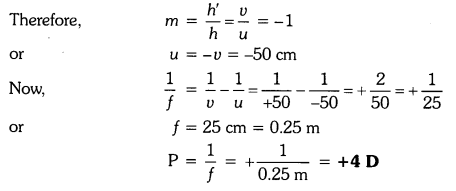
Question 3
Find the power of a concave lens of focal length 2 m.
Solution:
Because the focal length of a concave lens is negative,
therefore f = -2 m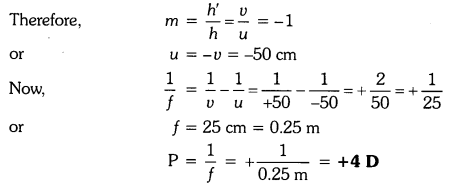
Textbook Chapter End Questions
Question 1
Which one of the following materials cannot be used to make a lens ?
(a) Water
(b) Glass
(c) Plastic
(d) Clay
Answer:
(d) Clay
Question 2
The image formed by a concave mirror is observed to be virtual, erect and larger than the object. Where should be the position of the object ?
(a) Between the principal focus and the centre of curvature
(b) At the centre of curvature
(c) Beyond the centre of curvature
(d) Between the pole of the mirror and its principal focus.
Answer:
(d) Between the pole of the mirror and its principal focus.
Question 3
Where should an object be placed in front of a convex lens to get a real image of the size of the object ?
(a) At the principal focus of the lens (b) At twice the focal length
(c) At infinity
(d) Between the optical centre of the lens and its principal focus.
Answer:
(b) At twice the focal length.
Question 4
A spherical mirror and a thin spherical lens have each a focal length of -15 cm. The mirror and the lens are likely to be :
(a) Both concave.
(b) Both convex.
(c) the mirror is concave and the lens is convex.
(d) the mirror is convex, but the lens is concave.
Answer:
(a) Both concave
Question 5
No matter how far you stand from mirror, your image appears erect. The mirror is likely to be
(a) plane
(b) concave
(c) convex
(d) either plane or convex.
Answer:
(d) Either plane or convex.
Question 6
Which of the following lenses would you prefer to use while reading small letters found in a dictionary ?
(a) A convex lens of focal length 50 cm.
(b) A concave lens of focal length 50 cm.
(c) A convex lens of focal length 5 cm.
(d) A concave lens of focal length 5 cm.
Answer:
(c) A convex lens of focal length 5 cm.
Question 7
We wish to obtain an erect image of an object, using a concave mirror of focal length 15 cm. What should be the range of distance of the object from the mirror ? What is the nature of the image ? Is the image larger or smaller than the object ? Draw a ray diagram to show the image formation in this case.
Answer:
A concave mirror gives an erect image when the object is placed between the focus F and the pole P of the concave mirror, i.e., between 0 and 15 cm from the mirror. The image thus formed will be virtual, erect and larger than the object.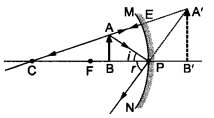
Question 8
Name the type of mirror used in the following situations.
(a) Headlights of a car.
(b) Side/rear-view mirror of a vehicle.
(c) Solar furnace.
Support your answer with reason.
Answer:
(a) Concave mirrors are used as reflectors in headlights of cars. When a bulb is located at the focus of the concave mirror, the light rays after reflection from the mirror travel over a large distance as a parallel beam of high intensity.
(b) A convex mirror is used as a side/rear-view mirror of a vehicle because
- A convex mirror always forms an erect, virtual and diminished image of an object placed anywhere in front it.
- A convex mirror has a wider field of view than a plane mirror of the same size.
(c) Large concave mirrors are used to concentrate sunlight to produce heat in solar furnaces.
Question 9
One-half of a convex lens is covered with a black paper. Will this lens produce a complete image of the object ? Verify your answer experimentally. Explain your observations.
Answer:
A convex lens forms complete image of an object, even if its one half is covered with black paper. It can be explained by considering following two cases.
Case I : When the upper half of the lens is covered
In this case, a ray of light coming from the object will be refracted by the lower half of the lens. These rays meet at the other side of the lens to form the image of the given object, as shown in the following figure.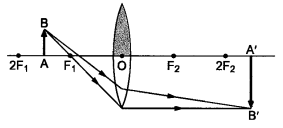
Case II: When the lower half of the lens Is covered
In this case, a ray of light coming from the object is refracted by the upper half of the lens. These rays meet at the other side of the lens to form the image of the given object, as shown in the given figure.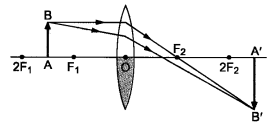
Question 10
An object 5 cm in length is held 25 cm away from a converging lens of focal length 10 cm. Draw the ray diagram and find the position, size and the nature of the image formed.
Answer:
Here : Object distance, u= -25 cm,
Object height, h = 5 cm,
Focal length, f = +10 cm
According to the lens formula,
⇒
The positive value of v shows that the image is formed at the other side of the lens.
The negative value of image height indicates that the image formed is inverted.
The position, size, and nature of image are shown alongside in the ray diagram.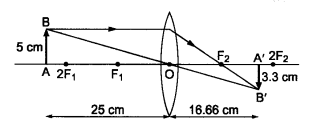
Question 11
A concave lens of focal length 15 cm forms an image 10 cm from the lens. How far is the object placed from the lens ? Draw the ray diagram.
Solution:
Focal length, f = -15 cm, Image distance, ν = -10 cm (as concave lens forms the image on the same side of the lens)
From the lens formula 
Object distance, u = -30 cm
The negative value of u indicates that the object is placed in front of the lens.
Question 12
An object is placed at a distance of 10 cm from a convex mirror of focal length 15 cm. Find the position and nature of the image.
Solution:
Object distance, u = -10 cm, Focal length, f = +15 cm, Image distance, ν = ?
Thus, image distance, ν = + 6 cm
Because ν is +ve, so a virtual image is formed at a distance of 6 cm behind the mirror.
Magnification,
The positive value of m shows that image erect and its value, which is less than 1, shows that image is smaller than the object. Thus, image is virtual, erect and diminished.
Question 13
The magnification produced by a plane mirror is +1. What does this mean ?
Answer:
Since magnification,
(i) m = 1 indicates the size of image is same as that of object.
(ii) positive sign of m indicates that an erect image is formed.
The opposite signs of ν and u indicate that image is formed on the other side of the mirror from where the object is placed i.e., image is formed behind the mirror and thus image formed is virtual.
Question 14
An object 5.0 cm in length is placed at a distance of 20 cm in front of a convex mirror of radius of curvature 30 cm. Find the position of the image, its nature and size.
Solution:
Since object size, h = +5 cm,
object distance, u = -20 cm
and radius of curvature, R = +30 cm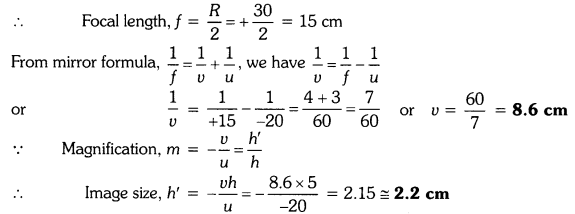
A virtual, erect image of height 2.2 cm is formed behind the mirror at a distance of 8.6 cm from the mirror.
Question 15
An object of size 7.0 cm is placed at 27 cm in front of a concave mirror of focal length 18 cm. At what distance from the mirror should a screen be placed, so that a sharp focussed image can be obtained ? Find the size and the nature of the image.
Answer:
Here, object size, h = +7.0 cm,
object distance, u = -27 cm
and focal length, f = -18 cm
Image distance, ν = ?
and image size, h’ = ?
From the mirror formula, 
The screen should be placed at a distance of 54 cm on the object side of the mirror to obtain a sharp image.
The image is real, inverted and enlarged in size.
Question 16
Find the focal length of a lens of power -2.0 D. What type of lens is this ?
Answer:
Here, P = -2.0 D
The type of lens is concave because the focal length is negative.![]()
Question 17
A doctor has prescribed a corrective lens of power +1.5 D. Find the focal length of the lens. Is the prescribed lens diverging or converging ?
Answer:
Here, P = +1.5 D![]()
Because the focal length is positive, the prescribed lens is converging.
--- Frequently Asked Questions ---
Question 1.
Which one of the following materials cannot be used to make a lens?
(a) Water (b) Glass
(c) Plastic (d) Clay
Answer: (d) Clay
Question 2.
The ¡mage formed by a concave mirror is observed to be virtual, erect and larger than the object. Where should be the position of the object?
(a) Between the principal focus and the centre of Curvature
(b) At the centre of curvature
(c) Beyond the centre of curvature
(d) Between the pole of the mirror and Its principal focus.
Answer: (d) Between the pole of the mirror and its principal focus.
Question 3.
Where should an object b. placed In front of a convex lens to get a real
image of the size of the object?
(a) At the principal focus of the lens
(b) At twice the focal length
(c) At infinity
(d) Between the optical centre of the lens and its principal focus
Answer:
(b) At twice the focal length
Question 4.
A spherical mirror and a thin spherical lens have each a focal length of 15 cm. The mirror and the lens are likely to be:
(a) both concave
(b) both convex
(c) the mirror is concave, but the lens is convex
(d) the mirror is convex, but the lens is concave
Answer:
(a) Both concave.
Question 5.
No matter how far you stand from a mirror, your Image appears erect. The mirror is likely to be
(a) plane
(b) concave
(c) convex
(d) Either plane or convex
Answer:
(d) Either plane or convex.
Question 6.
Which of the following lenses would you prefer to use while reading small letters found ¡n a dictionary?
(a) A convex lens of focal length 50cm
(b) A concave lens of focal length 50cm
(c) A convex lens of focal length 5 cm
(d) A concave lens of focal length 5 cm.
Answer:
(c) A convex lens of focal length 5 cm.
Question 7.
We wish to obtain an erect image of an object, using a concave mirror of focal length 15 cm. what should be the range of distance of the object from the mirror? What is the nature of the image? Is the image larger or smaller than the object? Draw a ray diagram to show the image formation in this
case.
Answer:
We are given the focal length cf the concave mirror as f = -15cm.
For getting an erect image using a concave mirror, the object should be placed at a distance less than the focal length.
i.e. 15 cm from the pole. The image formed will be virtual, enlarged and erect.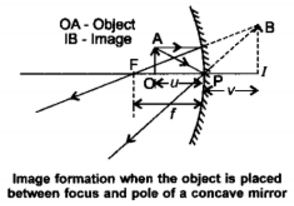
Question 8.
Name the type of mirror used in the following situations.
(a) Headlights of a car
(b) Side/rear-view mirror of a vehicle
(c) Solar furnace
Support your answer with reason.
Answer:
(a) Concave mirror, to get powerful and parallel beams of light.
(b) Convex mirror because it always gives an erect image and enables the driver to view much larger area.
(c) Concave or parabolic mirror because it can concentrate sunlight at the focus to produce heat in the solar furnace.
Question 9.
One half of a convex lens is covered with a black paper. Will this lens produce a complete image of the object? Verify your answer experimentally. Explain your observations.
Answer:
Yes, even when one half of the lens is covered with a black paper, complete image of the object will be formed. Take a convex lens and focus the light from a distant object onto a screen. As expected an image (sharp) is formed at a distance equal to the focal length Cover the lower or the upper half of the lens and focus the light from the same object onto the same screen. You will be able to get a sharp image again; however the brightness of the image will be less in the second case. The same effect w,ll be seen even if the lens is half covered with black strips.
Question 10.
An object 5cm in length is held 25cm away from a converging lens of focal length 10 cm. Draw a ray diagram and find the position, size and the nature of the image formed.
Answer: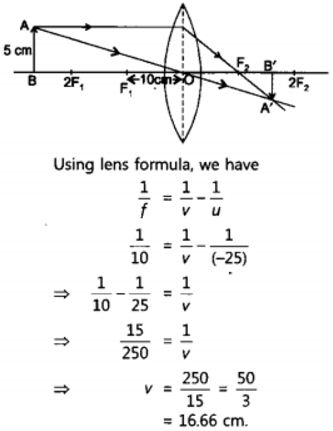
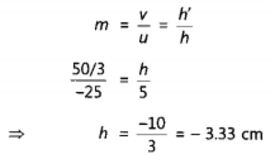
Therefore, the mage ¡s formed between F2 and 2F2 on the other side of the lens. It is real and inverted, and smaller in size than the object.
Question 11.
A concave lens of focal length 15 cm forms an ¡mage 10 cm from the lens. How far is the object placed from the Pens? Draw the ray diagram.
Answer: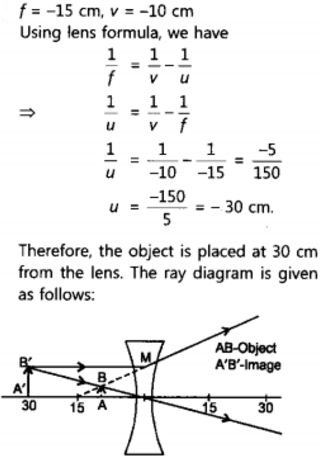
Question 12.
An object is placed at a distance of 10 cm from a convex mirror of focal length 15 cm. Find the position and nature of the ¡mage.
Answer:
f = +15 cm. u = -1o cm
For mirror, we have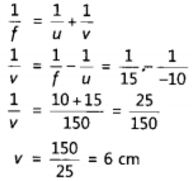
The image must be virtual and erect.
Question 13.
The magnification produced by a plane mirror is +1. What does this mean?
Answer:
This means that size of the image is equal to the size of the object.
Question 14.
An object 5.0 cm in length Is placedat a distanc, of 20 cm in front of a convex mirror of radius of curvature 30 cm. Find the position of the image nature and size.
Answer: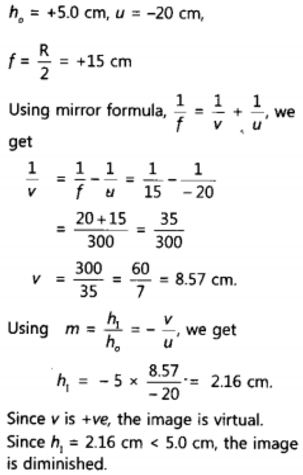
Question 15.
An object of size 7.0 cm is placed at 27 cm in front of a concave mirror of focal length 18 cm. At what distance from the mirror should a screen be placed, so that a sharp focused image can be obtained? Find the size and the nature of the image.
Answer: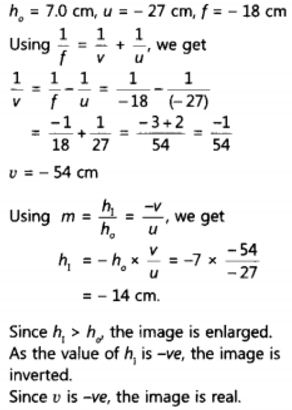
Question 16.
Find the focal length of a lens of power -2.0 D. What type of lens is this?
Answer: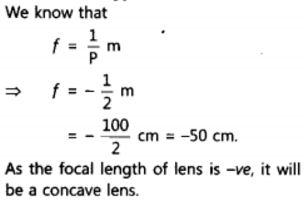
Question 17.
A doctor has prescribed a corrective lens of power +1.5 D. find the focal length of the lens. Is the prescribed lens diverging or converging?
Answer: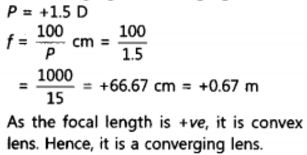
Multiple Choice Questions (MCQs) [1 mark each]
Question 1.
Hold a highly polished steel spoon curved inwards close to your face and move it slowly away from your face. What will you observe?
(a) Enlarged and erect image of your face
(b) Smaller and inverted image of your face
(c) Smaller and erect image of your face
(d) Enlarged and inverted image of your face
Answer:
(b) The inner curved surface of a highly polished steel spoon acts as a concave mirror. When the spoon is at a small distance from the face such that, the object lies between pole and focus of concave mirror, so an enlarged and erect image of your face will be observed but as the spoon is slowly moved away from the face, the image becomes smaller and appears inverted.
Question 2.
Which one of the following materials cannot be used to make a lens? [NCERT]
(a) Water
(b) Glass
(c) Plastic
(d) Clay
Answer:
(d) Clay can never be transparent, so it cannot be used to make lens.
Question 3.
No matter how far you stand from a mirror, your image appears erect. The mirror is likely to be [NCERT]
(a) plane
(b) concave
(c) convex
(d) either plane or convex
Answer:
(d) Plane mirrors and convex mirrors always form the erect images.
Question 4.
The image formed by a concave mirror is observed to be virtual, erect and larger than the object. Where should be the position of the object? [NCERT]
(a) Between principal focus and centre of curvature
(b) At centre of curvature
(c) Beyond centre of curvature
(d) Between pole of the mirror and its principal focus
Answer:
(d)
Question 5.
An object AB is placed in front of a convex lens at its centre of curvature as shown in figure below.
Four students traced the path of light ray after refraction through the lens. Which one of them is correct?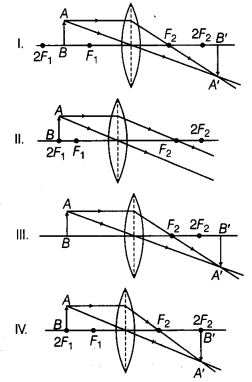
(a) Only I
(b) Only II
(c) Only III
(d) Only IV
Answer:
(d) When the object is placed at centre of curvature (2Fx) of convex lens, the same sized image is formed at 2F2. The image formed is real and inverted.
Question 6.
A spherical mirror and a thin spherical lens have each of a focal length -15 cm. The mirror and lens are likely to be [NCERT]
(a) both concave
(b) both convex
(c) mirror is concave and lens is convex
(d) mirror is convex and lens is concave
Answer:
(a) The focal length is taken as negative for both concave mirror and concave lens.
Question 7.
Which of the following can make a parallel beam of light when light from a point source is incident on it? [NCERT Exemplar]
(a) Concave mirror as well as convex lens
(b) Convex mirror as well as concave lens
(c) Two plane mirrors placed at 90° to each other
(d) Concave mirror as well as concave lens
Answer:
(a) A ray passing through the principal focus of a concave mirror or convex lens, after reflection/refraction, will emerge parallel to the principal axis.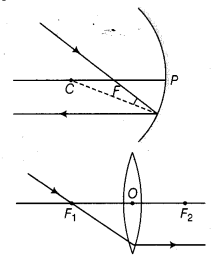
Question 8.
Under which of the following conditions, a concave mirror can form an image larger than the actual object? [NCERT Exemplar]
(a) When an object is kept at a distance equal to its radius of curvature
(b) When an object is kept at a distance less than its focal length
(c) When an object is placed between the focus and centre of curvature
(d) When an object is kept at a distance greater than its radius of curvature
Answer:
(c) A concave mirror can form an image enlarged, real and inverted than the actual object, beyond centre of curvature (C) when object is placed between the focus (F) and centre of curvature.
Question 9.
A light ray enters from medium A to medium Bas shown in the figure. The refractive index of medium B relative to A will be [NCERT Exemplar]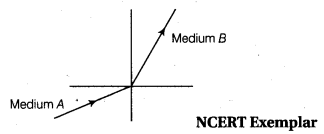
(a) greater than unity
(b) less than unity
(c) equal to unity
(d) zero
Answer:
(a) Since, light rays in the medium B goes towards normal. So, it has greater refractive index and lesser velocity of light w.r.t. medium A. So, refractive index of medium B w.r.t. medium A is greater than unity.
Question 10.
Figure shows a ray of light as it travels from medium A to medium B. Refractive index of the medium B relative to medium A is
Answer:
(a) Given, angle of incidence, i = 60°, angle of refraction, r = 45°
Refractive index of the medium B relative to medium A,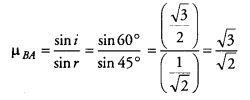
Question 11.
Beams of light are incident through the holes A and B and emerge out of box through the holes C – and D respectively, as Box shown in the figure.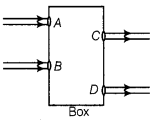
Which of the following could be inside the box? [NCERT Exemplar]
(a) A rectangular glass slab
(b) A convex lens
(c) A concave lens
(d) A prism
Answer:
(a) Here, the emergent rays are parallel to the direction of the incident ray. Therefore, a rectangular glass slab could be inside the box as the extent of bending of light ray at the opposite parallel faces AB (air-glass interface) and CD (glass-air interface) of the rectangular glass slab are equal and opposite. This is why the ray emerges parallel to the incident ray.
Question 12.
A beam of light is incident through the holes on side A and emerges out of the holes on the other face of the box as shown in the figure. Which of the following could be inside the box? [NCERT Exemplar]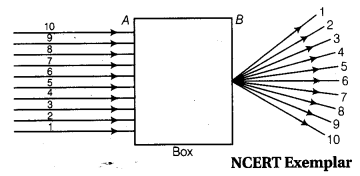
(a) Concave lens
(b) Rectangular glass slab
(c) Prism
(d) Convex lens
Answer:
(d) Since, in the figure all the parallel rays converge at a point. So, inside the box there must be a convex lens.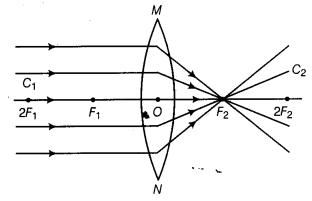
Question 13.
Which of the following statement is true? [NCERT Exemplar]
(a) A convex lens has 4D power having a focal length 0.25 m
(b) A convex lens has 4D power having a focal length -0.25 m
(c) A concave lens has 4D power having a focal length 0.25 m
(d) A concave lens has 4D power having a focal length -0.25 m
Answer:
(a) The power P of a lens of focal length f is given by
P = 1/f, where f is the focal length in metre and P is the power in dioptre.
P= 1/f or f = 1/P = 1/4 = 0.25 m
Question 14.
Magnification produced by a rear view mirror fitted in vehicles [NCERT Exemplar]
(a) is less than one
(b) is more than one
(c) is equal to one
(d) can be more than or less than one depending upon the position of the object in front of it.
Answer:
(a) The convex mirror forms virtual, erect and diminished image of the object and rear view mirror also form same type of image. Therefore, magnification (m) produced by a rear view mirror fitted in vehicles is less than one, i.e. m < 1.
Question 15.
Rays from the Sun converge at a point 15 cm in front of a concave mirror. Where should an object be placed, so that size of its image is equal to the size of the object? [NCERT Exemplar]
(a) 15 cm in front of the mirror
(b) 30 cm in front of the mirror
(c) between 15 cm and 30 cm in front of the mirror
(d) more than 30 cm in front of the mirror
Answer:
(b) The rays from the Sun, i.e. from infinity, are parallel to principal axis after reflection converge at a point is known as focus. Therefore, focal length if) of concave mirror is 15 cm. And we know that, same size, real and inverted image is formed by concave mirror when object is placed at focus 2 A or centre of curvature, so to form same size of image, object will be placed at 15 x 2 =30 cm.
Question 16.
The path of a ray of light coming from air passing through a rectangular glass slab traced by four students shown as I, II, III and IV in the figure. Which one of them is correct? [NCERT Exemplar]
(a) Only I
(b) Only II
(c) Only III
(d) Only IV
Answer:
(b) In a rectangular glass slab, the emergent rays are parallel to the direction of the incident ray, because the lateral deviation of bending of the ray of light at the opposite parallel faces (air-glass interface) and (glass-air interface) of the rectangular glass slab are equal and opposite. This is why the ray emerges are parallel to the incident ray.
Question 17.
You are given water, mustard oil, glycerine and kerosene. In which of these media, a ray of light incident obliquely at same angle would bend the most? [NCERT Exemplar]
(a) Kerosene
(b) Water
(c) Mustard oil
(d) Glycerine
Answer:
(d) The given material having their refractive index as kerosene is 1.44, water is 1.33, mustard oil is 1.46 and glycerine is 1.74. Thus, glycerine is most optically denser and hence have the largest refractive index. Therefore, ray of light bend most in glycerine.
Question 18.
A student placed a light bulb in midway between the two plane mirrors inclined at an angle of 60°. How many images will be observed by him?
(a) 4
(b) 6
(c) 5
(d) 8
Answer:
(c) Number of images formed by two plane mirrors inclined at an angle 60° when a light bulb is placed in midway between them is
N = 360°/60° – 1 = 6 – 1 = 5
Question 19.
Where should an object be placed in front of a convex lens to get a real image of the size of the object? [NCERT]
(a) At the principal focus of the lens
(b) At twice the focal length
(c) At infinity
(d) Between the optical centre of the lens and its principal focus
Answer:
(b) To set the real image of the size of the object, it should be placed at twice the focal length of a convex lens.
Question 20.
Which of the following lenses would you prefer to use while reading small letters found in dictionary? [NCERT]
(a) A convex lens of focal length 50 cm
(b) A concave lens of focal length 50 cm
(c) A convex lens of focal length 5 cm
(d) A concave lens of focal length 5 cm
Answer:
(c) Convex lens is used as magnifying glass. For better performance its focal length should be small.
Give Us Your Feedback/Suggestions
- By Durgesh Pandey
(Eklavya Coaching Institute)
📞 8376976688
H-2/25, Gali No-23, Kunwar Singh Nagar, Nangloi, New Delhi -110041




Comments
Post a Comment